MXA RACE TEST: EVERYTHING YOU NEED TO KNOW ABOUT THE 2016 KTM 250SXF
Q: FIRST AND FOREMOST, IS THE 2016 KTM 250SXF BETTER THAN THE 2015 250SXF?
A: Absolutely! In fact, the 2016 KTM 250SXF is substantially better in every conceivable way. Whereas the 2015 model was a warmed-over version of the old design, the 2016 KTM 250SXF is all new. That’s because KTM poured resources into making the 2015-1/2 Factory Edition 250SXF. As a result, KTM addressed many of MXA’s complaints, creating a superior bike that overshadows any of its predecessors.
Q: IS THE 2016 KTM 250SXF BETTER THAN THE 2015-1/2 KTM 250SXF FACTORY EDITION?
A: You might think that the 2016 model is essentially the same as the 2015-1/2 KTM 250SXF Factory Edition, only devoid of the orange frame, aftermarket hop-ups and Red Bull graphics; however, although they are similar under the hood, the two models are noticeably distinct. How can the 2016 model, separated by only a few months on the production line from the Factory Edition, be so different? KTM used the Factory Edition as a stalking horse to learn what they needed to do to make the 2016 model better. And better is what KTM is striving for. There is no need to remind you that KTM is the only Big Five manufacturer to invest in a 350cc four-stroke, a Factory Edition program, electric starting and an expansive line of two-strokes. It makes sense that the 2016 KTM 250SXF is different from the 2015-1/2, even if the changes are subtle.
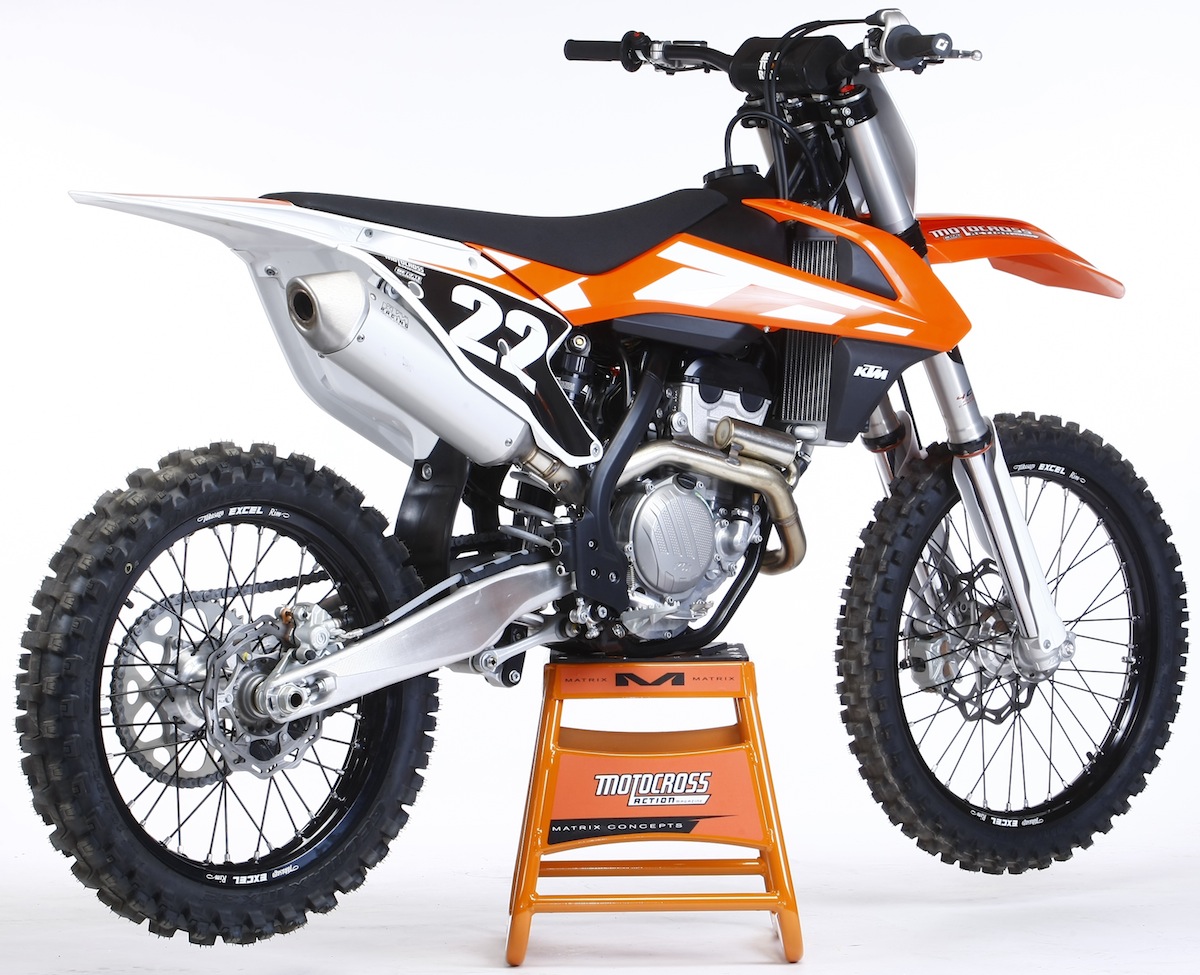 2016 KTM 250SXF: Thanks to increased horsepower across the range, the 2016 250SXF feels stronger in the middle than past versions, but this isn’t a midrange engine by any stretch.
2016 KTM 250SXF: Thanks to increased horsepower across the range, the 2016 250SXF feels stronger in the middle than past versions, but this isn’t a midrange engine by any stretch.
To answer the question, the 2016 model is ever-so-slightly better than the Factory Edition (FE). It all comes down to the WP 4CS fork settings, which are more forgiving and rider-friendly than what came standard on the FE. Having said that, anyone with a penchant for classic design would prefer the Factory Edition’s look. With its orange powdercoated frame, factory graphics, anodized parts and blue seat cover, the bike looks race-ready. In truth, MXA would prefer to see next year’s Factory Edition mimic the actual KTM factory bikes a little more closely. We’d like to see Cone Valve forks, a Trax shock and works Brembo calipers as opposed to anodized foof. Yes, they would cost even more, but there would be more “factory” in the Factory Editions.
Q: WHAT CHANGES WERE MADE TO THE 2016 KTM 250SXF?
A: There’s no reason to delve into the major changes between the 2016 KTM 250SXF and the previous generation. Why? The list of updates would run a mile long and be the same as the list we made when the Factory Editions were introduced. Suffice it to say that everything—including the switch from Dunlop MX52 tires to the competition-spec MX32 tread—has been changed.
Q: WHAT ARE THE DIFFERENCES BETWEEN THE 2016 KTM 250SXF AND THE 2015-1/2 FACTORY EDITION?
A: Even though the 2015-1/2 KTM 250SXF Factory Edition is only six months old, KTM’s test crew found several bugaboos worth changing for 2016. Below is the list of updates made to a bike that was all new to begin with:
(1) 4CS forks. The WP 4CS forks were re-valved for a softer and more progressive feel through the stroke. The shim stack isn’t completely different from what came in the Factory Edition, but MXA test riders complained that the Factory Edition forks were rather stiff and harsh. Thus, WP’s goal was to provide a plusher feel.
(2) WP shock. Between the forks and shock, the rear end received more attention. Why? KTM wanted the 250SXF to feel more balanced fore to aft, so they softened up the shock settings. The settings are considerably softer than what came on the FE.
(3) Radiators. The radiators are comprised of a new aluminum alloy designed for improved durability. The radiator guards have a new ventilation system for greater efficiency and notches to allow dirt and roost to escape.
(4) Chain guide. The rear chain guide has been lengthened to help guide the chain onto the sprocket teeth more effectively.
(5) Frame color. We’re not sure why KTM would ditch the popular orange powdercoated frame in favor of black. It’s a move that won’t sit well with diehard KTM owners, who lusted for years after an orange frame, only to have KTM pull the color after one year. Goodbye, RAL2009 powdercoating. We hardly knew you.
(6) Graphics. Obviously the Red Bull KTM graphics are gone. The 2016 graphics are rather plain, and the cryptic KTM logo is barely discernible.
(7) Brake rotors. The Galfer Wave brake rotors are lighter by approximately 1-1/2 ounces (front and rear). They have a new vent pattern, and a keen eye will notice the magnet fitting for the odometer on the offroad models.
(8) Wheels. The silver spokes have been replaced with black spokes. It’s important to note that KTM had been applying a special coating to the spokes for years but discovered that durability was sacrificed.
(9) Mapping. KTM changed the mapping on the 2016 model for easier starting, more fuel down low and a better transition from low to the midrange.
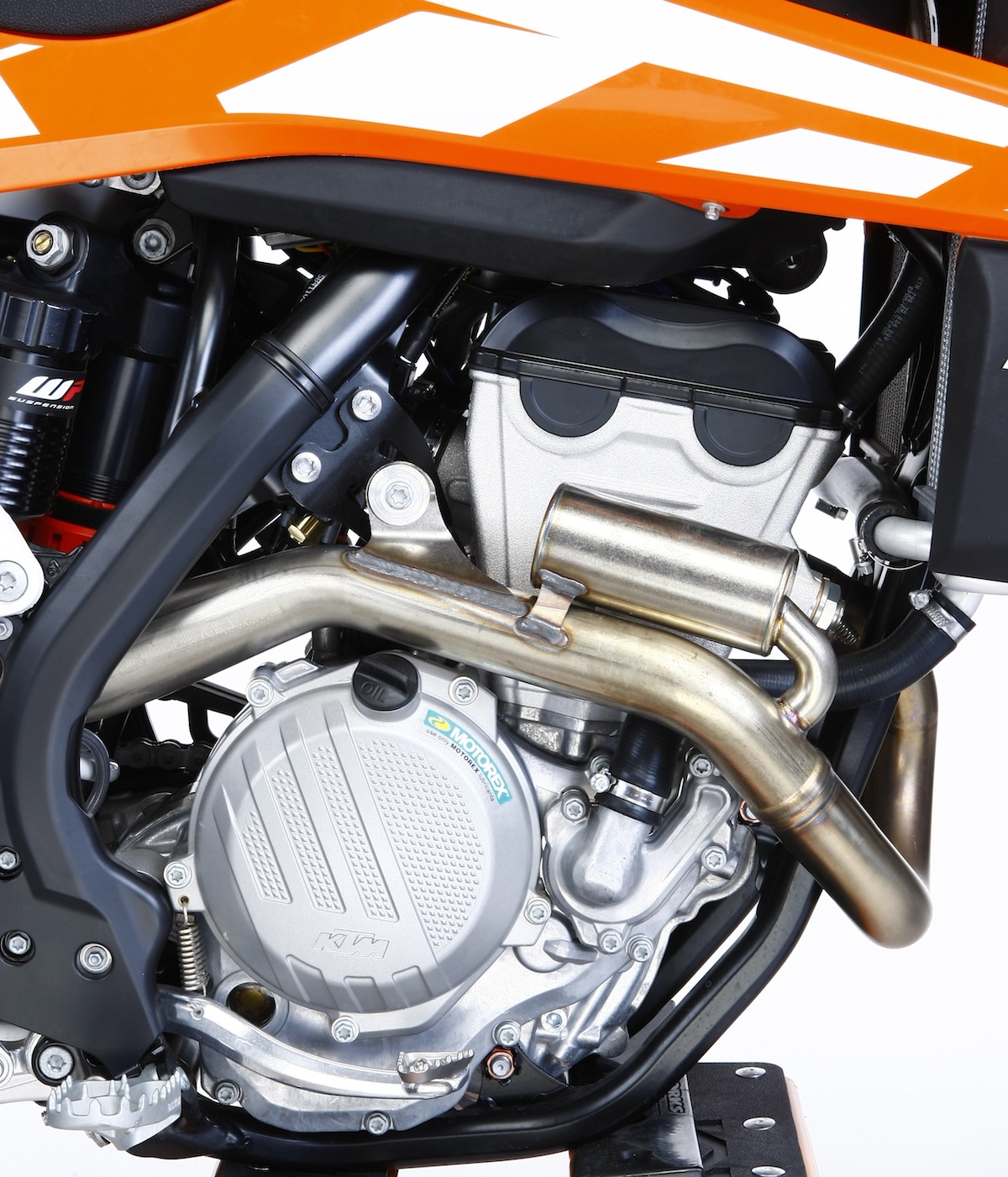 Welcome: After years of complaining, MXA test riders were finally given the KTM 250SXF engine they desired. It rips.
Welcome: After years of complaining, MXA test riders were finally given the KTM 250SXF engine they desired. It rips.
Q: WHAT ARE THE REDEEMING QUALITIES OF THE 2016 KTM 250SXF?
A: Several things stand out on the KTM 250SXF that differentiate it from anything else on the market. If the following characteristics are what you’re looking for in a 250 four-stroke, then find happiness knowing that KTM has met your needs.
(1) Weight. On MXA’s scale, the 2016 KTM 250SXF weighs 221 pounds (without fuel). That makes it the lightest bike in the class. KTM managed to knock 8 pounds off the 2015 model while still keeping the electric starter. In motion, the 2016 KTM 250SXF feels nimble, but that lightweight sensation doesn’t translate as well while soaring over jumps. We’re not complaining, though. Bravo to KTM for putting the 250SXF on SlimFast.
(2) Electric starter. For years the MXA wrecking crew battled internal demons when asked whether the 250SXF electric starter was worth the extra heft. Call us lazy, but every test rider overlooked the excess baggage, because starting the KTM with the push of a button was so easy. The positives outweighed the negatives. For 2016, the electric starter is a non-issue. KTM used a compact and lightweight battery that is 2.2 pounds lighter. The engineers also shaved weight in the starter drive.
(3) Power. The KTM 250SXF has long been tops on the dyno charts, and that trend continues for 2016; however, the previous iterations of the 250SXF engine were misguided. They pumped out serious ponies, but with the caveat that the dyno curve resembled a hard piece of spaghetti. There wasn’t any bottom or midrange hit. And while the 2016 KTM 250SXF isn’t going to pull stumps out of the ground, the totally new engine (cylinder head, valve train, throttle body, cylinder, piston, crankshaft, transmission, cases and clutch) has a more usable powerband with better delivery. Mission accomplished.
(4) Durability. Thanks to ceaseless development, the life expectancy of a 250 four-stroke is no longer shorter than that of a mayfly. There are always certain bikes that outlast the competition. The KTM 250SXF is one such bike. It takes a licking and keeps on ticking. This wasn’t always so, but the new bike is the product of a new pride at KTM. Despite our best efforts to destroy the transmission and float the
valves, it held up well.
Q: HOW FAST IS THE 2016 KTM 250SXF?
A: It is mind-numbingly fast from 12,000 rpm until giving up the ghost at 13,900 rpm. Speed is not the question. The machine can do it, but do you have the talent to keep the throttle grip twisted beyond the point of self-preservation? Certainly the KTM 250SXF has no equal at full tilt—aside from its kissing cousin, the Husqvarna FC250. If you are not ready to fully commit, then you are not ready for the 250SXF.
How fast is the 250SXF in the parts of the powerband where normal riders spend the bulk of their time? It’s stronger down low than ever; however, the bottom end is not overly impressive. True, it is worlds better than the 2015 model; then again, a banana slug has more get-up-and-go than the old engine. Off idle, the 2016 KTM 250SXF snaps to attention, not with the fervor of the Yamaha YZ250F or Kawasaki KX250F, but with enough thrust to wake you up. Once in the midrange, the surge is decent enough to demand respect. Where the Pro riders live in that high-rpm stratosphere is where the KTM 250SXF has no peers. If you are fast, this is the fastest bike you will ever race. If you are slow, we have two words of advice—don’t shift. You gotta make this baby rev to get to where the power is. To summarize, the 2016 engine is like Andre the Giant trying to play a ukulele. It doesn’t always hit the right notes, but there’s an atomic boom once the right chords are strummed.
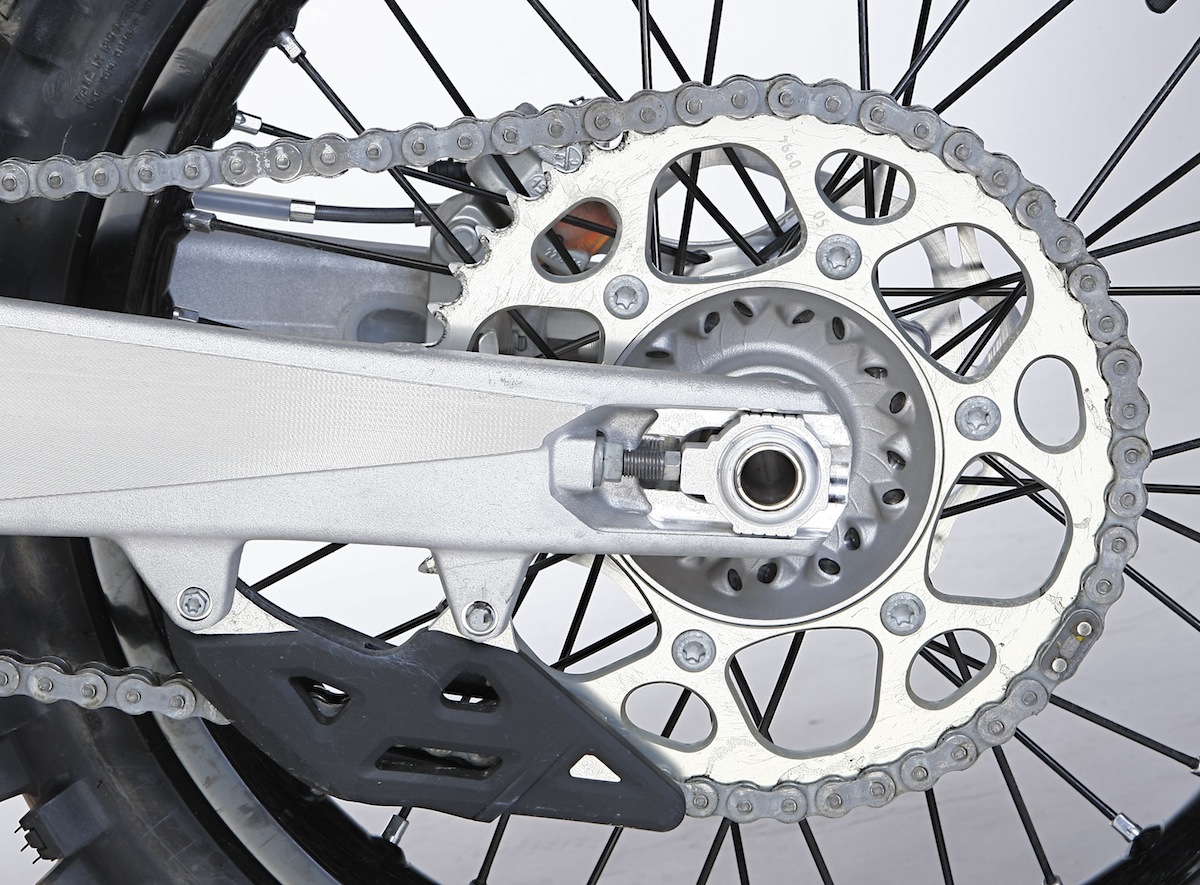 Up or down: Adding a tooth to the rear sprocket is best on tight tracks, but most riders preferred to drop down to a 49.
Up or down: Adding a tooth to the rear sprocket is best on tight tracks, but most riders preferred to drop down to a 49.
Q: HOW DOES THE 2016 KTM 250SXF RUN ON THE DYNO?
A: Very well, thank you. KTM has always taken the approach that more power is better, evidenced by its Bonneville Salt Flats-specific engines. The 2016 KTM 250SXF doesn’t disappoint on the dyno. We were able to reach 43.79 horsepower at peak, with 20.20 foot-pounds of torque. It eclipsed 40 ponies from 11,000 rpm until 13,900 rpm. The dyno curve shows that the 2016 model is superior to the 2015 engine, from 5000 rpm until 6500 rpm, and then they mirror each other until 10,800 rpm, where the new engine rockets to within a hair of the 44-horsepower barrier.
Amazingly, the 2016 KTM 250SXF doesn’t make the most horsepower in the 250 class, that honor falls to the Husqvarna FC250 at 44.38 horsepwer (which just happens to have a KTM engine in it). KTM and Husky have a 4 to 6 horsepower gap on the Japanese brands. That is a major horsepower advantage. The best Japanese bike on the dyno is the KX250F at 39.88 horsepower.
Q: HOW DOES THE 2016 KTM 250SXF RUN ON THE TRACK?
A: For many years, the KTM 250SXF had a Pro-only powerband. For the Austrians to pigeonhole the 250SXF into such a small category—one where most riders receive discounts or want free equipment—made little sense…or cents. And while the 2016 KTM 250SXF isn’t necessarily working in the same rpm territory as the YZ250F and KX250F, it is very adept at being ridden hard. But unlike the older 250SXF engines, the added midrange horsepower gives less aggressive riders a fighting chance to still be successful. Roll-on throttle delivery is tractable, and the powerband is peppy and a lot more fun. However, the midrange could still benefit from more explosiveness, but the KTM engineers know what’s buttering their bread — and that is high-rpm horsepower. Without sugar coating it, this is a powerband designed for Pros and Pro-wannbee’s. You have to rev it to 14,000 rpm to get peak horsepower out of it. And, you have to keep it pegged to make it work to its fullest. This is not a Novice engine.
There is never a reason to short-shift through the gears to keep the 250SXF engine humming from low to mid, because this bike has nothing in common with a 450 four-stroke. It’s best to let the rpm ramp up through the midrange and then hold on for dear life as the 250SXF climbs into the nether reaches of the rev limiter. Our best advice is to fight the urge to shift, because odds are your foot is twitching at least 1000 rpm too soon.
As for the difference between the powerbands of the Husqvarna FC250 and KTM 250SXF, the difference is largely one of throttle response and feel. The KTM revs quicker and the Husky feels torqier.
Q: WHAT ABOUT THE GEARING?
A: Gearing has always been an issue with the KTM 250SXF. And so it goes with the 2016, which has a 13/50 combination. On tight tracks, we geared the bike down with a 51-tooth sprocket to get to third gear sooner. Paradoxically, on bigger tracks we preferred to gear the bike up with a 49-tooth rear sprocket, which allowed test riders to remain in the meat of the powerband longer. Plus, with the taller gearing, there was less load on the suspension in the rough. Fast rider can carry the taller gearing, while slower riders will have to spend more time in second gear. The 2017 KTM 250SXF will have 14/51 gearing, which would be like putting very tall 13/48 gearing on the 2016 model.
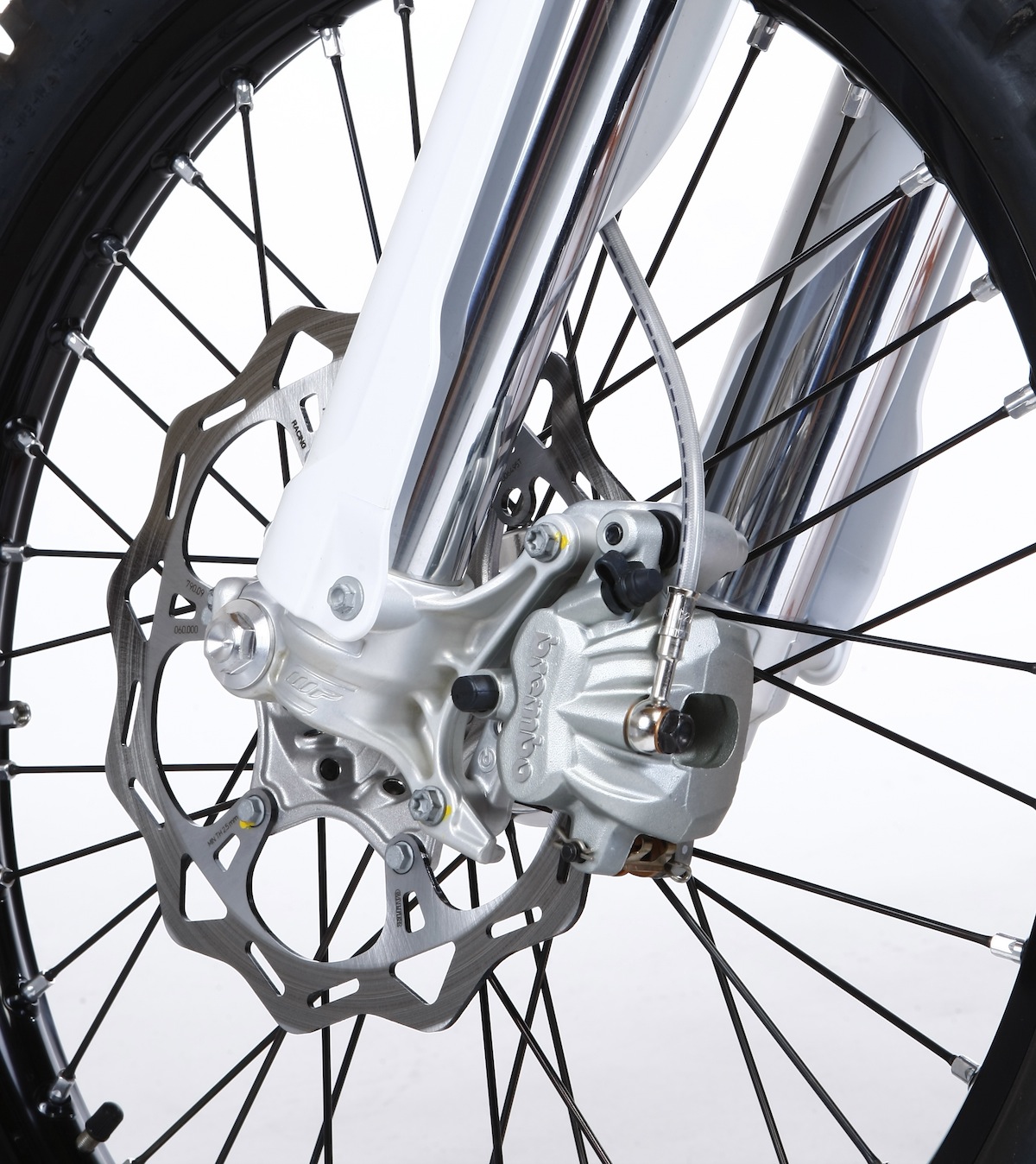 No doubts: Every manufacturer’s front brake–aside from Husqvarna–pales in comparison to the KTM Brembo unit.
No doubts: Every manufacturer’s front brake–aside from Husqvarna–pales in comparison to the KTM Brembo unit.
Q: WHAT ABOUT THE ELECTRONIC AIDS?
A: We pulled the airbox cover off, unearthed the map dial that was tucked away under the seat, and switched to the aggressive map (Map 2). This setting opened up the powerband, and while KTM includes a map that detunes the engine (Map 1), we would rather meter traction with the throttle. As for the launch control switch on the handlebars, which doubles as the map switch, every test rider preferred not to run it. We believe that lessening wheelspin on a 250 four-stroke off the start is more of a hindrance than a help. To learn the intricacies of how to activate the launch control mode on the KTM 250SXF, be sure to consult the August 2015 issue of MXA. It’s a confusing process.
Q: HOW GOOD ARE THE WP 4CS FORKS?
A: They’re good for Vet and Novices. Not great. To be frank, for more years than we care to remember the 250SXF forks were hindered by incredible mid-stroke harshness. Pulling oil out of the bleeder holes was merely a band-aid fix. KTM decided to try something different for 2016. The engineers gave up on their old valving concept and lessened the mid-stroke harshness. The 2016 WP 4CS forks emphasize a plusher feel.
Our fastest test riders could bottom the forks over big jumps, but for small riders, Novices, Vets and natural-terrain tracks, it was the first time that we were willing to turn the compression clicker in. In the past, we always went out, hoping to alleviate the harshness. We welcome the change. It was a daring move to build forks that work better for average riders than fast riders, but it was based on the novel idea that average riders buy more KTMs than AMA Pros. Overall, the forks were monumentally better than what came on any 250SXF prior to this year. Yet, not as good as Yamaha SSS forks.
Q: HOW DOES THE 2016 KTM 250SXF HANDLE?
A: The KTM 250SXF is a conundrum. It is the Dr. Jekyll and Mr. Hyde of motocross bikes. Why? The chassis is superb, but to make it work, you have to get the suspension balanced. On smooth tracks with manicured berms, the 250SXF handles like an F-22 Raptor. The suspension remains balanced, helping provide traction for an engine that wants to scream. On rough tracks with square-edge bumps, however, the KTM is capable of exacting revenge for past transgressions.
KTM has a little more work to do to solve the mystery of damping, spring rate and shock linkage geometry. KTM did help the frame’s peccadilloes by increasing the torsional rigidity while lessening longitudinal stiffness. The changes steady the chassis, but the shock needs more work. The soft settings are good for svelte and slower riders, but any ham-fisted throttle jockey will quickly discover the downside to KTM’s setup. Loading the rear end forces the shock to drop into its stroke and create a seesaw effect between the front and rear end. We remedied the problem by adjusting the sag and going in on the high-speed compression. Even with our issues, we vastly prefer 2016’s softer settings, because they allow more wiggle room for the target audience.
 Quick change: The map switch is on the bars.
Quick change: The map switch is on the bars.
Q: WHAT CHANGES DID WE MAKE TO IMPROVE THE 2016 KTM 250SXF?
A: We found solace by making these changes:
(1) Mapping. Do yourself a favor: Dig out the map switch in the airbox and set the dial to Map 2. Once it’s programmed into the ECU, you activate it by flicking the handlebar-mounted switch rearward to the two dash marks. It only takes a minute to change. Best of all, it’s free.
(2) Gearing. How strange. We geared it up and we geared it down, but we didn’t stick with the stock gearing.
(3) Exhaust pipe. We made great strides in the power department after installing various aftermarket exhaust systems. To date, we’ve had our best luck with the FMF Factory 4.1 (www.fmfracing.com). It added bottom-end hit and was most noticeable through the midrange.
Q: WHAT DID WE HATE?
A: The hate list:
(1) Black frame. For years we’ve begged KTM to powdercoat its frames orange, and it finally did…for one year. Bring back the orange!
(2) Shock collar. Be very kind to the plastic shock collar. It doesn’t take much abuse before it’s rendered incapable of adjustment. We lube the threads after washing the bike and always pry the preload ring with a long screwdriver rather than hitting it with a punch.
(3) Gearbox. Shifting wasn’t an issue, but finding neutral in the pits was next to impossible. As soon as you turn the engine off—it jumps into neutral with a tiny click. We accept that bikes that are hard to get into neutral are less likely to pop into neutral at speed.
(4) Spokes. Yet again, the spokes nearest the rim locks become loose in short order. Watch all of them like a hawk.
(5) Gas cap. Don’t overtighten the gas cap or you may never be able to loosen it again.
(6) Sprocket bolts. We recommend applying copious amounts of blue Loctite to the threads.
(7) Exhaust. Removing the stock exhaust requires several annoying steps, including removing the shock.
(8) Brake pedal spring. Turn the brake pedal spring around so that the tang that goes through the top of the brake pedal in facing inward. We were able to accidentally push the spring off the brake pedal when the tang faced outwards,. We also crimp the tangs so that fit tighter.
(9) Shifter tip spring. We broke the shifter tip springs on two of our test KTM’s—although not on our 250SXF. In a pinch we wrap the shift tip in duct tape to finish the day.
(1o) Crossbar pad. It may sound picky, but we don’t like how the crossbar pad shifts back and forth on the handlebars.
(11) Fork clickers. Although you love the ability to change the compression and rebound settings on the WP forks without having to dig in the toolbox for a screwdriver, the cog-shaped clicker needs to have longer cogs so that the clicks can be made much quicker and easier.
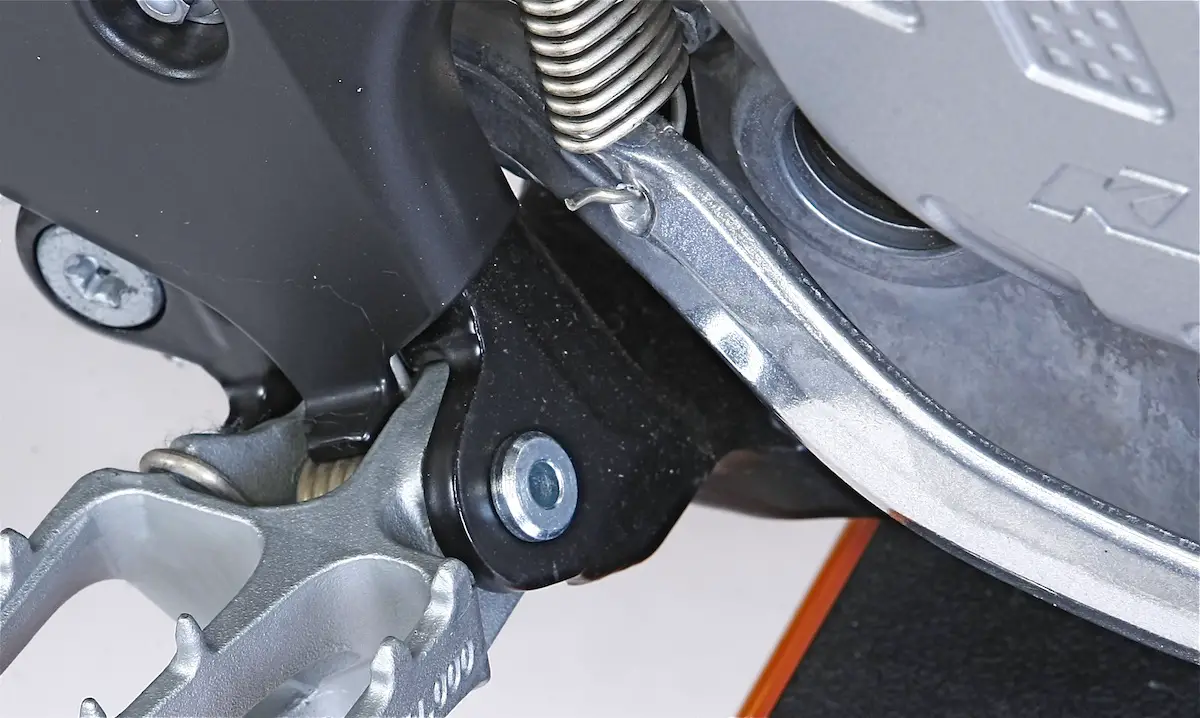 If your brake pedal spring sticks through with the tang facing outward (as above), turn it around so that the tang faces inward. You can knock it loose with your boot if you don’t change it.
If your brake pedal spring sticks through with the tang facing outward (as above), turn it around so that the tang faces inward. You can knock it loose with your boot if you don’t change it.
Q: WHAT DID WE LIKE?
A: The like list:
(1) Weight. The KTM 250SXF tips the scales at 221 pounds, and that’s with an electric starter. Very nice.
(2) Tires. KTM took a risk by equipping its motocross lineup with Dunlop MX32 intermediate tires instead of tires that last longer but don’t perform as well. We love the MX32 tread. One caveat. If you ride them on hard terrain the side knobs will tear off.
(3) Brakes. They need no introduction.
(4) Powerband. KTM woke a sleeping giant in the 250SXF engine. It’s a high-rpm romper. Its 43.76 horsepower is a new production-bike record.
(5) Accouterments. It’s hard to go wrong with a hydraulic clutch, in-mold graphics, self-cleaning footpegs, no-clog shift lever, ODI lock-on grips, launch control switch, easy-access air filter and preprogrammed maps.
(6) Suspension. While we don’t love the WP units, they are considerably better than anything offered on previous KTM 250SXF models.
(7) Radiator design. Every manufacturer should look at the thought that KTM’s engineers put into getting air to actually flow through their radiator cores.
(8) Clutch. Honda, Yamaha, Suzuki and Kawasaki took 10 years to catch up to KTM’s braking power. How long until they build a self-adjusting, long-lasting, reliable hydraulic clutch.
(9) Electric start. Yes you can start a Honda, Yamaha, Suzuki or Kawasaki without electric starting, but since the KTM 250SXF is as light as a bike gets, why wouldn’t you want it.
(10) Handling. Once you balance the front and rear, you can go anywhere and do anything…without trying. Part of the KTM 450’s charm is its handling. Thanks to its 2016 diet, electric powerband and improved suspension, this bike can be steered with your knees.
(11) Air filter. The plug-and-play air filter is a very creative idea.
(12) Little things. This is not a BNG bike or an updated old design. It is new from the ground up. That shows — not just in the all-new engine, frame and plastic, but in the minor details that make a difference. The footpegs, shift lever, air filter, fuel lines, crossbar pad, chain guide,resonance chamber, CNC hubs and double-duty headstay/pipe mount all show that KTM cares.
A: KTM just keeps popping out new machines. The 2016 KTM 250SXF powerplant is the best ever. Who would have thought a few years ago that a production 250 would pump out 44 horses? We love the revamped powerband, which although still focused on Pro riders is usable by riders of all skill levels. While the WP suspension isn’t anything to write home about, at least it moves now. Plus, it’s hard to overlook the plethora of upgrades unique to KTM that add to an already sterling package. The KTM 250SXF has rounded the corner and is edging to the front.
MXA’S KTM 250SXF SETUP SPECS
This is how we set up our 2016 KTM 250SXF for racing. We offer it as a guide to help you find your own sweet spot.
4CS FORK SETTINGS
“Plush” is the best word to describe the WP 4CS forks. They are geared towards light riders who don’t put too much energy into the front end. We cranked in on the clickers until they stopped bottoming and used the rebound to slow down the ramping-up effect. For hard-core racing, we recommend this fork setup on the 2016 KTM 250SXF (stock specs are in parentheses):
Spring rate: 4.6 N/m
Oil height: 100cc
Compression: 6 clicks out (15 clicks out)
Rebound: 10 clicks out (15 clicks out)
Fork-leg height: 3mm up
Notes: We love that WP uses no-tools adjusters to make clicker changes a breeze. There’s no need to drop the oil height this year; in fact, we stiffened up the compression in order to keep the forks from bottoming. Fast riders might have to add 10cc of oil. The rebound adjuster is very sensitive and should be used sparingly. If the forks feel too stiff, don’t be afraid to turn them out — all the way out if necessary.
WP SHOCK SETTINGS
It’s nice that KTM embossed a sag-scale line on the rear fender to ensure that riders are measuring their race sag in the proper location. For hard-core racing, we recommend this shock setup for the 2016 KTM 250SXF (stock specs are in parentheses):
Spring rate: 45 N/m
Race sag: 105mm
Hi-compression: 1-1/2 turns out (2 turns out)
Lo-compression: 8 clicks out (15 clicks out)
Rebound: 6 clicks out (15 clicks out)
Notes: We turned the high-speed compression damping in to help hold the shock higher in its stroke, especially under a load. Depending on rider preference, we ran around 105mm of race sag to balance out the chassis. If you are very light, you will have trouble getting any preload on the 45 Newton-meter spring. You will need to go lighter.
MXA’S 2016 KTM 250SXF VIDEO



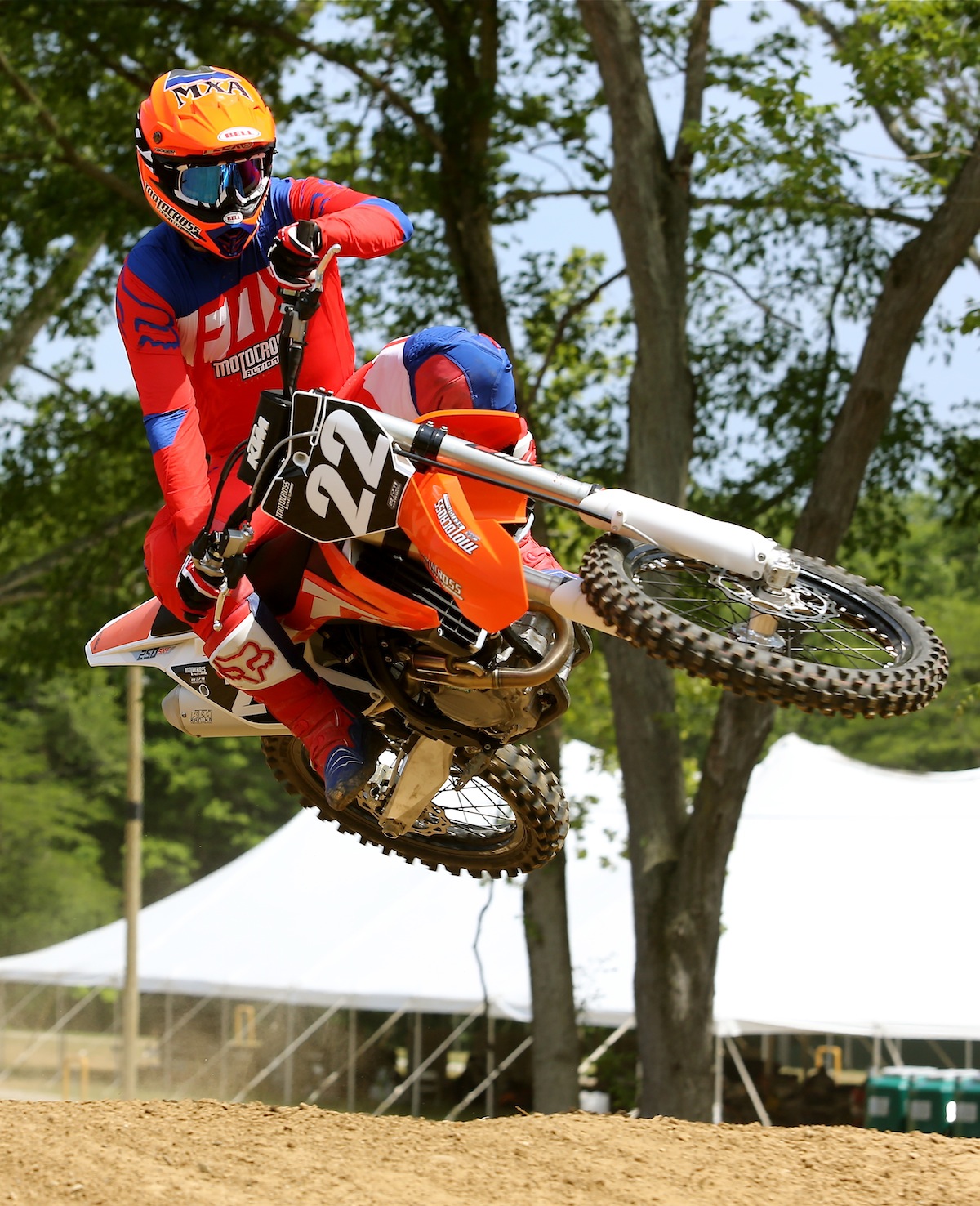
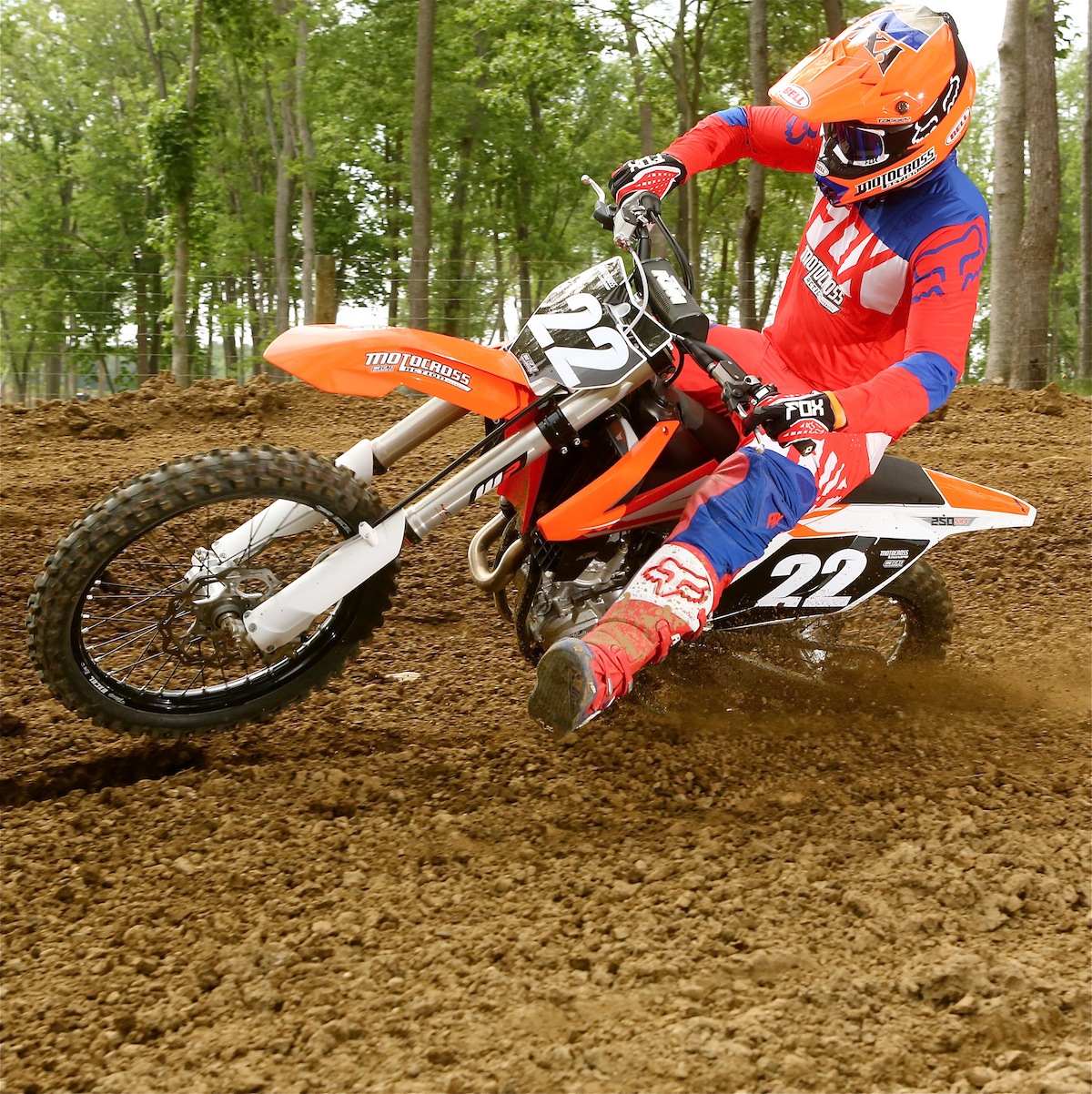
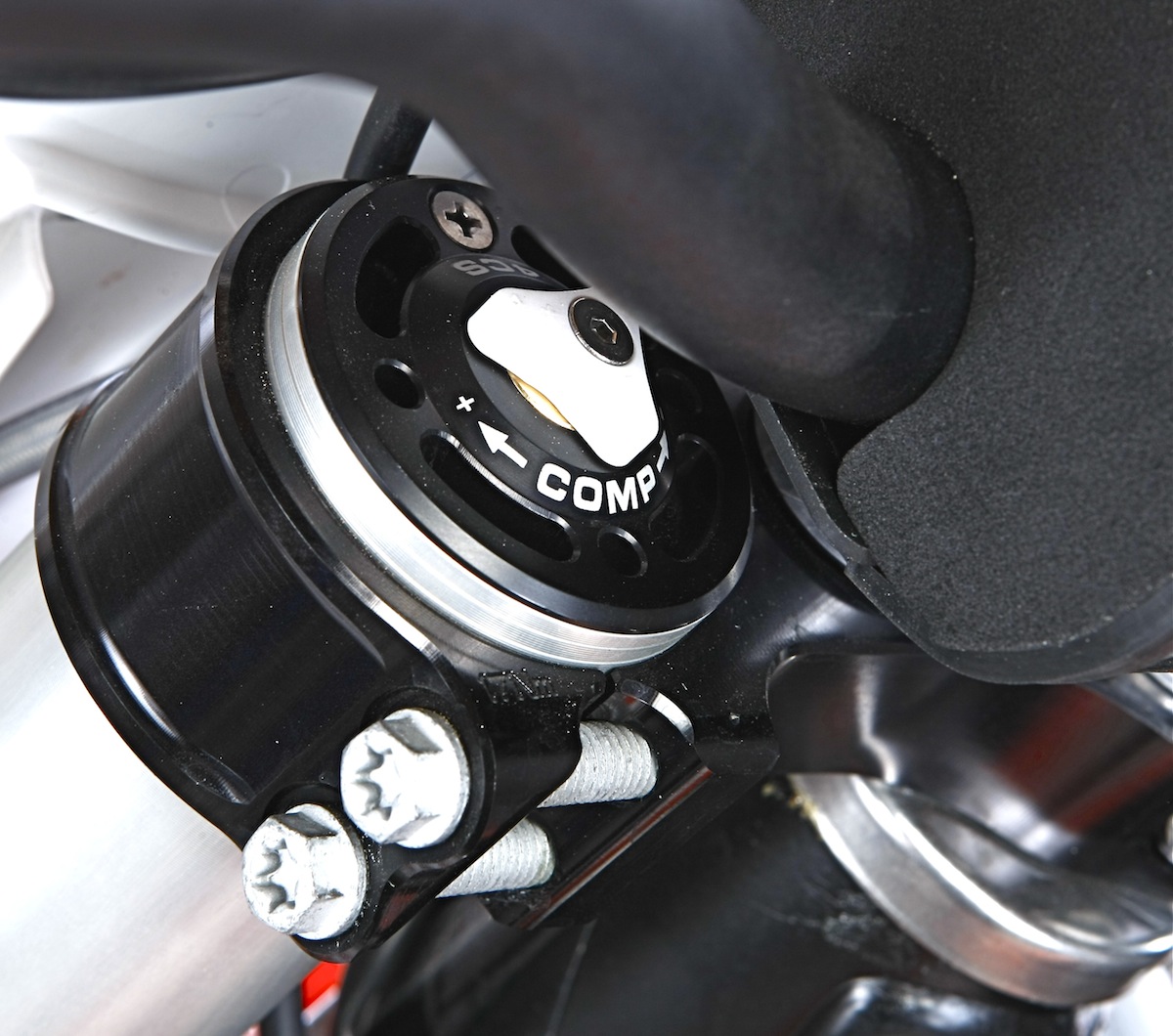

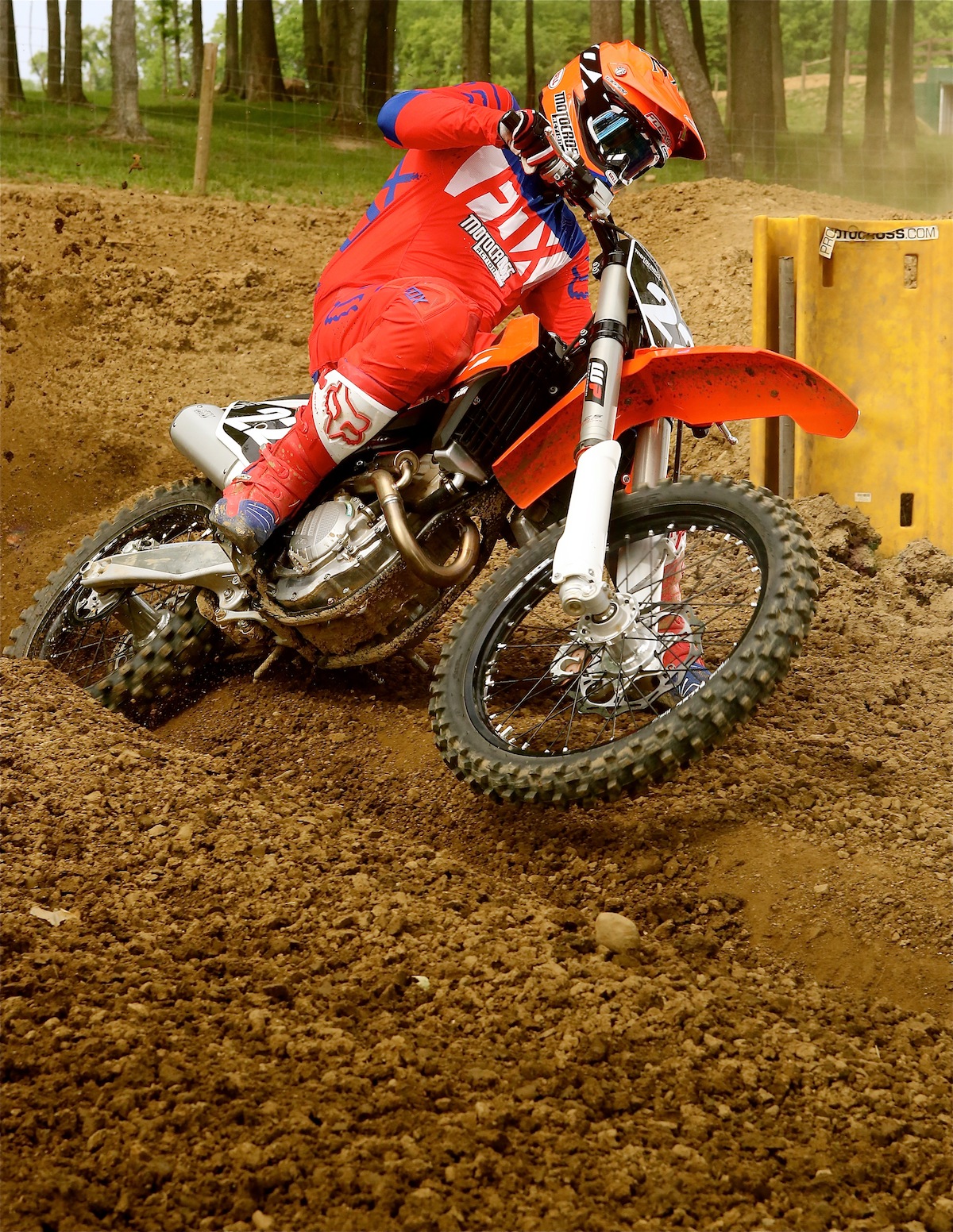
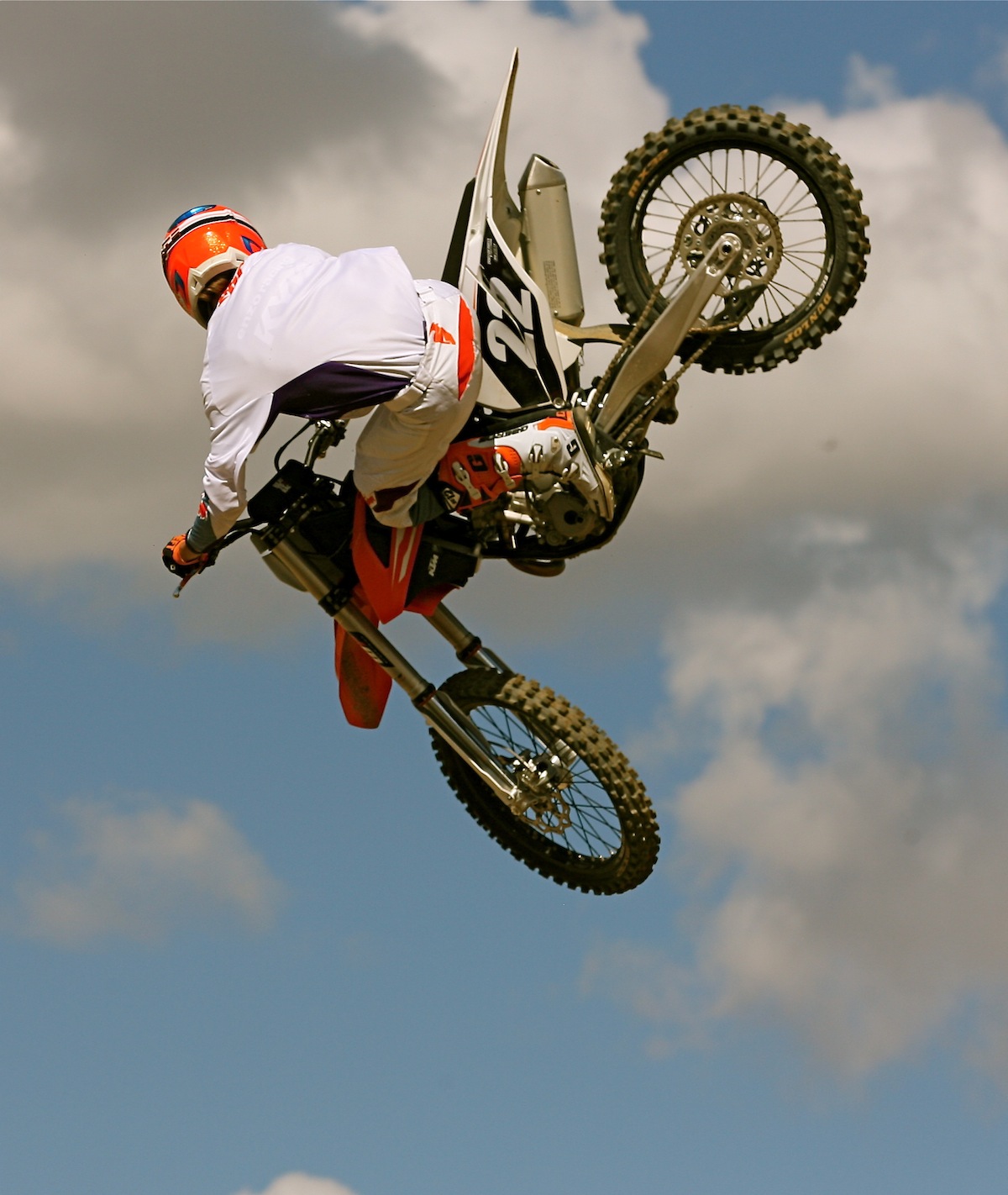
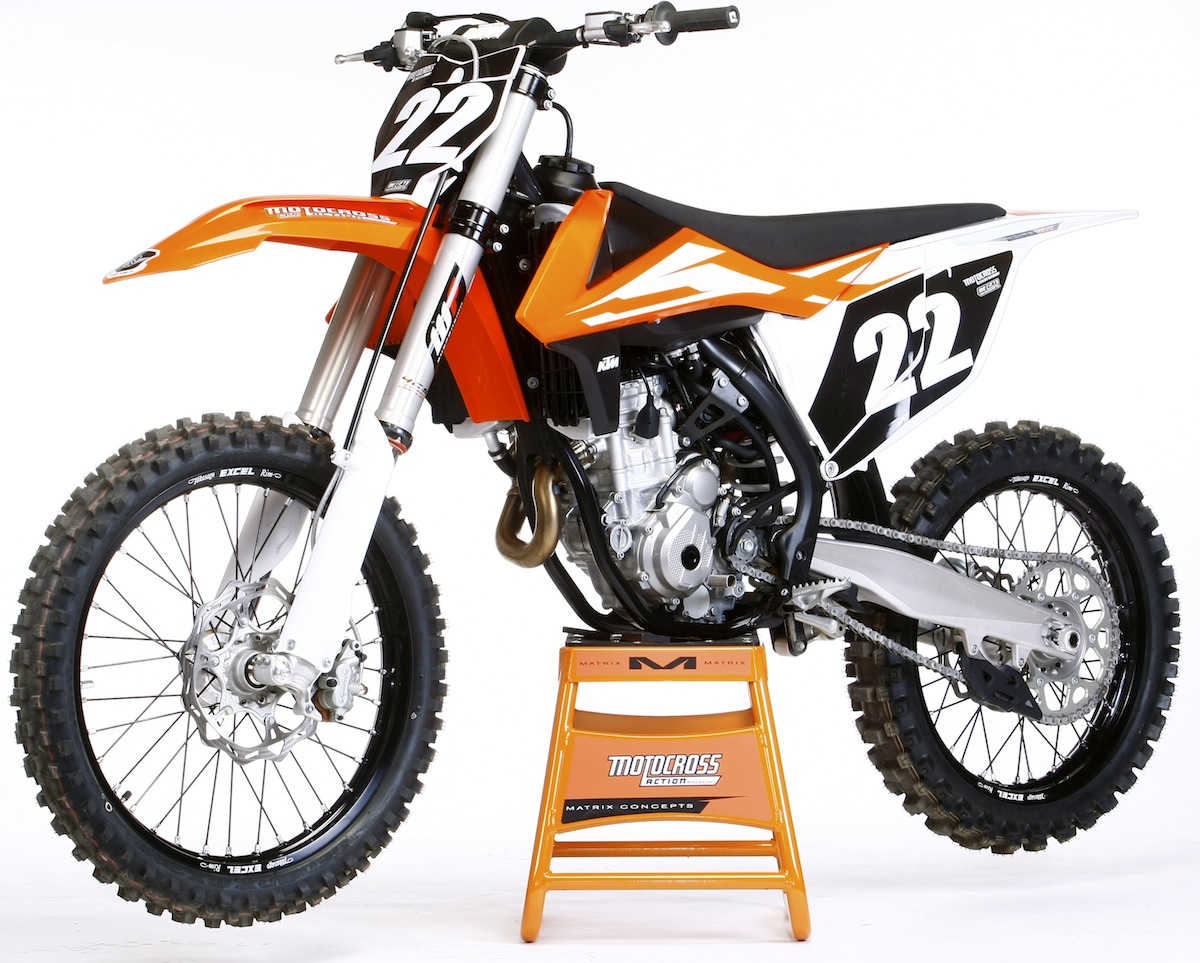



Comments are closed.